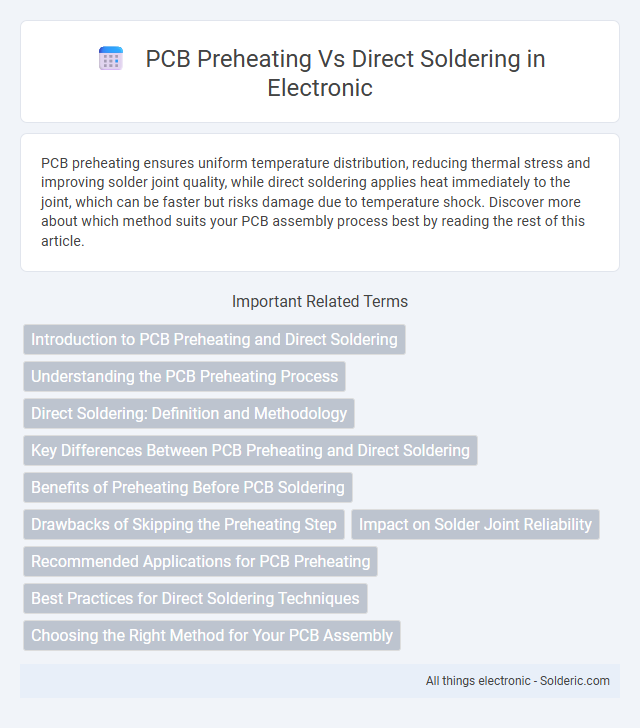PCB preheating ensures uniform temperature distribution, reducing thermal stress and improving solder joint quality, while direct soldering applies heat immediately to the joint, which can be faster but risks damage due to temperature shock. Discover more about which method suits your PCB assembly process best by reading the rest of this article.
Comparison Table
| Aspect | PCB Preheating | Direct Soldering |
|---|---|---|
| Process | Gradual heating of PCB before soldering | Immediate application of heat during soldering |
| Temperature Control | Controlled ramp-up, typically 100-150degC | Rapid heating, temperature spikes up to 250degC+ |
| Thermal Stress | Minimized thermal shock to components and PCB | Higher risk of thermal shock and damage |
| Solder Joint Quality | Improved joint reliability and wetting | Potential for cold joints or poor wetting |
| Process Speed | Longer due to preheating phase | Faster, single-step heating |
| Component Safety | Better protection of sensitive components | Higher risk of component damage |
| Energy Consumption | Generally higher due to extra heating step | Lower energy usage per unit time |
| Use Cases | Complex PCBs, multi-layer boards, heat-sensitive parts | Simple boards, robust components, quick fixes |
Introduction to PCB Preheating and Direct Soldering
PCB preheating ensures uniform temperature distribution across the board, reducing thermal stress and preventing damage during soldering. Direct soldering involves applying heat immediately to the solder joint, which can cause uneven heating and potential component warping. Understanding these techniques helps optimize Your soldering process for enhanced reliability and performance.
Understanding the PCB Preheating Process
PCB preheating involves gradually raising the temperature of the circuit board before direct soldering to reduce thermal shock and prevent component damage. This controlled heating ensures uniform temperature distribution, improving solder joint quality and minimizing defects like solder bridging or cold joints. Your manufacturing process benefits from enhanced reliability and reduced rework by optimizing the PCB preheating parameters.
Direct Soldering: Definition and Methodology
Direct soldering involves applying heat directly to the printed circuit board (PCB) and components without preliminary warming. This methodology requires precise temperature control and rapid heat transfer techniques to avoid thermal shock and component damage. It is commonly used for small-scale repairs or soldering of heat-resistant components where preheating is impractical.
Key Differences Between PCB Preheating and Direct Soldering
PCB preheating involves gradually raising the board's temperature to reduce thermal shock, improve solder flow, and minimize component stress, while direct soldering applies heat directly to the solder joints without prior warming. Preheating ensures uniform heat distribution across the PCB, enhancing solder joint reliability and preventing warping, whereas direct soldering offers faster processing but increases the risk of thermal damage and incomplete soldering. Understanding these differences helps you optimize soldering techniques for improved electronic assembly quality and longevity.
Benefits of Preheating Before PCB Soldering
Preheating a PCB before soldering improves solder joint quality by ensuring uniform temperature distribution, reducing thermal shock and minimizing the risk of component damage. This process enhances solder flow and wetting, resulting in stronger, more reliable connections and fewer defects like cold joints or solder bridges. Your overall manufacturing yield increases as preheating shortens soldering time and helps prevent warping or delamination of sensitive circuit boards.
Drawbacks of Skipping the Preheating Step
Skipping the preheating step in PCB soldering can lead to thermal shock, causing component damage and solder joint failure due to rapid temperature changes. Insufficient preheating increases the risk of poor solder wetting, resulting in weak or cold solder joints that compromise electrical reliability. Your PCB's overall durability and performance are at risk without proper preheating, as stress from uneven heating may cause warping or delamination.
Impact on Solder Joint Reliability
PCB preheating significantly enhances solder joint reliability by reducing thermal shock and ensuring uniform temperature distribution during soldering. Direct soldering without preheating often leads to cold solder joints and increased risk of component damage due to rapid temperature changes. Studies show that controlled preheating improves wetting and adhesion, resulting in longer-lasting, mechanically robust solder joints.
Recommended Applications for PCB Preheating
PCB preheating is highly recommended for complex assemblies with multiple components, fine-pitch devices, and large ground planes to prevent thermal shock and improve solder joint reliability. Your manufacturing process benefits from preheating when working with multilayer PCBs or sensitive components that require controlled, gradual temperature ramp-up to avoid warping and damage. This method ensures uniform heat distribution, reducing defects and enhancing soldering quality compared to direct soldering.
Best Practices for Direct Soldering Techniques
Optimal direct soldering techniques emphasize precise preheating of the PCB to 100-150degC to reduce thermal shock and improve solder joint quality. Using controlled preheating ensures even heat distribution, minimizing the risk of component damage and warping during soldering. You can achieve reliable and consistent solder joints by combining regulated preheating with proper soldering iron temperature settings and flux application.
Choosing the Right Method for Your PCB Assembly
Selecting the optimal PCB assembly method depends on factors like board complexity, component sensitivity, and thermal requirements. PCB preheating reduces thermal shock and enhances solder joint quality by gradually increasing the board temperature before soldering, which is ideal for multi-layer or high-density assemblies. Direct soldering suits simpler boards with robust components, offering faster processing but may increase the risk of thermal damage without proper heat management.
PCB preheating vs direct soldering Infographic

 solderic.com
solderic.com